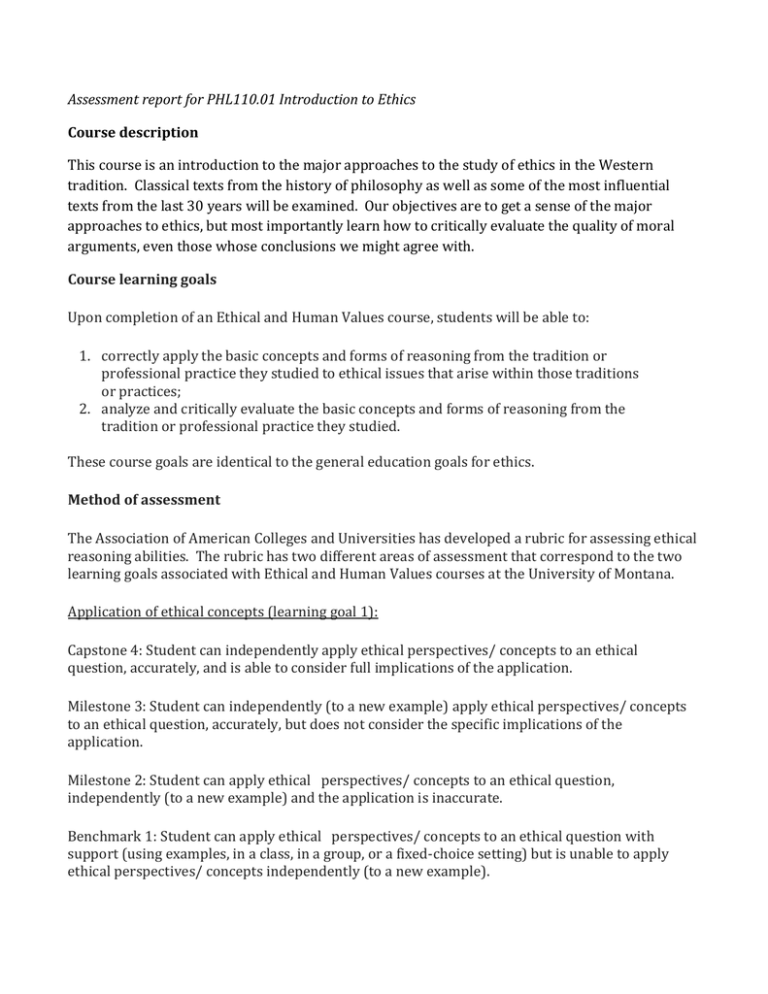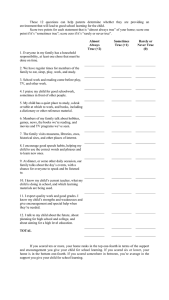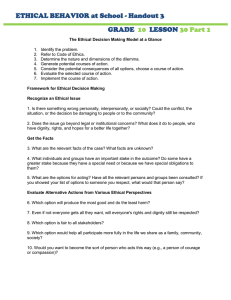Assessment report for PHL110.01 Introduction to Ethics Course description
advertisement

Assessment report for PHL110.01 Introduction to Ethics Course description This course is an introduction to the major approaches to the study of ethics in the Western tradition. Classical texts from the history of philosophy as well as some of the most influential texts from the last 30 years will be examined. Our objectives are to get a sense of the major approaches to ethics, but most importantly learn how to critically evaluate the quality of moral arguments, even those whose conclusions we might agree with. Course learning goals Upon completion of an Ethical and Human Values course, students will be able to: 1. correctly apply the basic concepts and forms of reasoning from the tradition or professional practice they studied to ethical issues that arise within those traditions or practices; 2. analyze and critically evaluate the basic concepts and forms of reasoning from the tradition or professional practice they studied. These course goals are identical to the general education goals for ethics. Method of assessment The Association of American Colleges and Universities has developed a rubric for assessing ethical reasoning abilities. The rubric has two different areas of assessment that correspond to the two learning goals associated with Ethical and Human Values courses at the University of Montana. Application of ethical concepts (learning goal 1): Capstone 4: Student can independently apply ethical perspectives/ concepts to an ethical question, accurately, and is able to consider full implications of the application. Milestone 3: Student can independently (to a new example) apply ethical perspectives/ concepts to an ethical question, accurately, but does not consider the specific implications of the application. Milestone 2: Student can apply ethical perspectives/ concepts to an ethical question, independently (to a new example) and the application is inaccurate. Benchmark 1: Student can apply ethical perspectives/ concepts to an ethical question with support (using examples, in a class, in a group, or a fixed-choice setting) but is unable to apply ethical perspectives/ concepts independently (to a new example). Evaluation of ethical concepts (learning goal 2): Capstone 4: Student states a position and can state the objections to, assumptions and implications of and can reasonably defend against the objections to, assumptions and implications of different ethical perspectives/ concepts, and the student's defense is adequate and effective. Milestone 3: Student states a position and can state the objections to, assumptions and implications of, and respond to the objections to, assumptions and implications of different ethical perspectives/ concepts, but the student's response is inadequate. Milestone 2: Student states a position and can state the objections to, assumptions and implications of different ethical perspectives/ concepts but does not respond to them (and ultimately objections, assumptions, and implications are compartmentalized by student and do not affect student's position.) Benchmark 1: Student states a position but cannot state the objections to and assumptions and limitations of the different perspectives/concepts. Over the course of two exams, each of the different areas of assessment were probed twice. Only data from students that completed all exams were included in the findings. Findings and assessment of findings First Assessment of learning goal 1: 5/46 scored below the benchmark, 4/46 scored at milestone 1, 4/46 scored at milestone 2, 20/46 scored at milestone 3, and 13/46 scored at the capstone level. Second Assessment of learning goal 1: 5/46 scored below the benchmark, 6/46 scored at milestone 1, 6/46 scored at milestone 2, 18/46 scored at milestone 3, and 11/46 scored at the capstone level. First Assessment of learning goal 2: 3/46 scored below the benchmark, 2/46 scored at milestone 1, 4/46 scored at milestone 2, 16/46 scored at milestone 3, and 21/46 scored at the capstone level. Second Assessment of learning goal 2: 1/46 scored below the benchmark, 6/46 scored at milestone 1, 7/46 scored at milestone 2, 16/46 scored at milestone 3, and 16/46 scored at the capstone level. The first assessment of learning goal 1 and the first and second assessments of learning goal 2 occurred on the third exam of the semester. The second assessment of learning goal 1 occurred on the final exam. Surprisingly, the first and second assessment of learning goal 2, which occurred on the same exam, revealed more variation than than the first and second assessments of learning goal 1, which occurred on different exams. There are two reasonable explanations for these results. Either there is variation present in the method of assessment, or students encountered more difficulty on one of the tasks than another. Action steps This initial data will be used to measure future achievements in meeting the general education learning goals. Increasing the number of students performing at the capstone level is a priority. In future courses, the benchmarks will be communicated to students, and they will be told that their grades will reflect how well they meet those benchmarks. Additionally, this initial assessment will provide examples that illustrate what it takes to achieve certain benchmarks. In future courses, an example of performance at each benchmark will be provided to students. More clearly communicating expectations to students should increase their performance.


